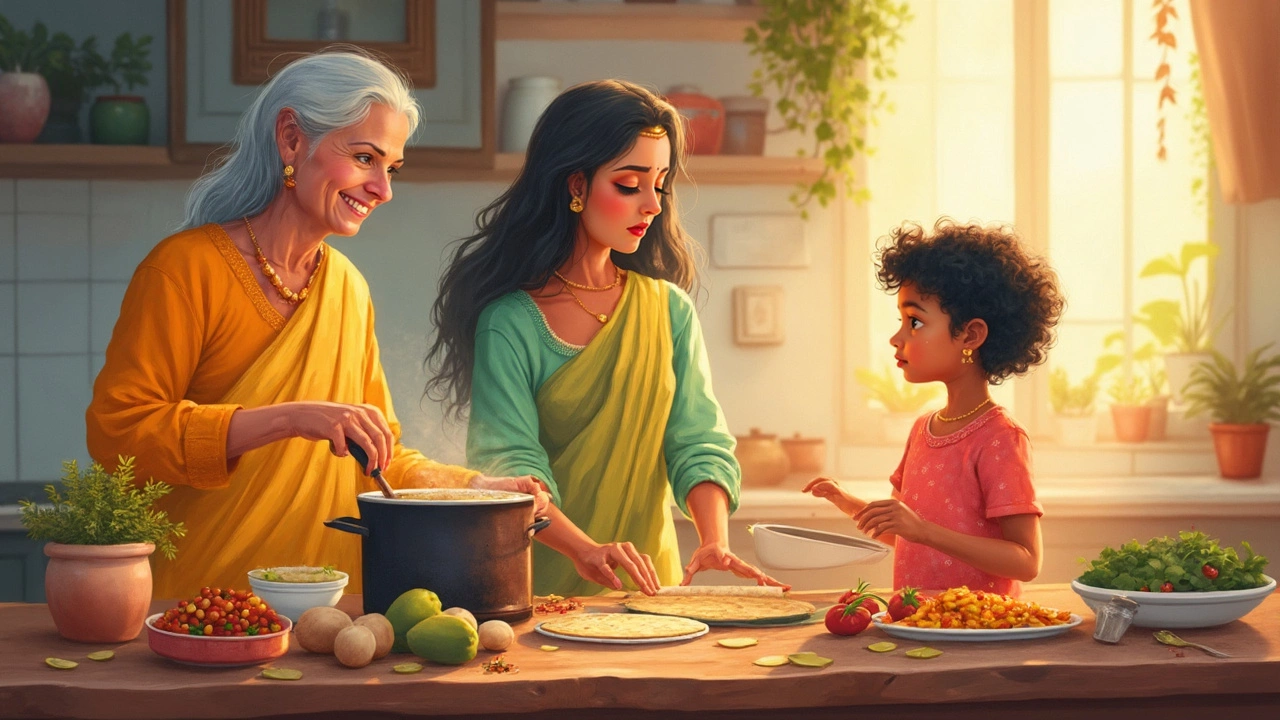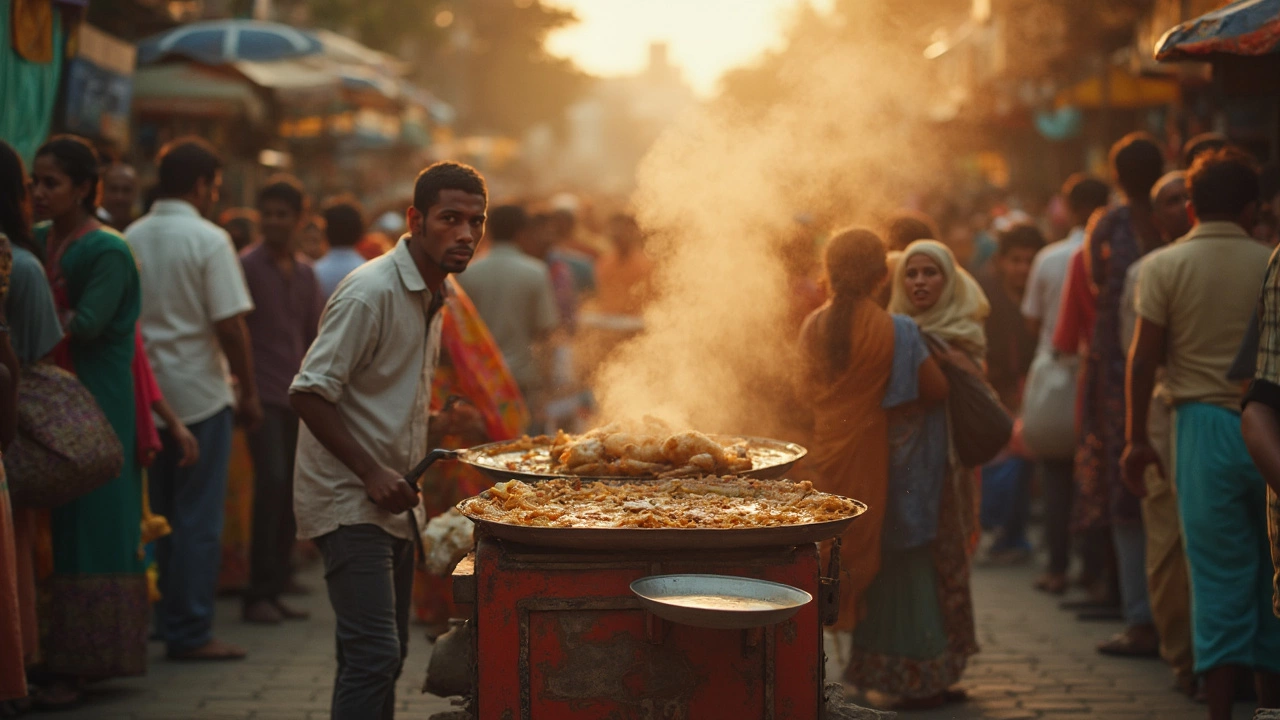Vegetarian food in India isn’t a backup plan—it’s the real deal. Almost a third of Indians eat a mostly plant-based diet. So, you’ll never feel like you’re missing out. From quick snacks on a busy afternoon to home-cooked meals that make you want seconds, there’s serious flavor in every bite.
If you’ve ever stared at an Indian menu feeling lost, or just wondered what all those lentils and veggies taste like when done right, you’re in the right place. Some of these dishes are older than your grandma’s grandma, but they still hit the spot today. And trust me, even hardcore meat-lovers reach for seconds when the spices are this good.
Ready to ditch the chicken tikka and try something new? Let’s break down the top veggie picks that actually fill you up and make dinner-time exciting again. Get set for big flavors, not boring salads.
- Street Food Stars
- Comfort Curries and Sabzis
- Rice and Bread Must-haves
- Smart Tips for Cooking or Ordering
Street Food Stars
If there’s one thing India nails, it’s street food. Even if you’re skipping meat, there’s no shortage of tasty options you’ll find on almost every corner. These aren’t just snacks—they’re a way of life in Indian cities. Vendors serve up veggie-packed, affordable bites that locals swear by.
- Paneer Tikka: Grilled cubes of Indian cheese, marinated in spices and yogurt. Think BBQ, but without the meat sweat. In Delhi alone, over 20,000 roadside joints sold paneer tikka daily in 2024. It’s filling, full of protein, and always a crowd favorite.
- Vada Pav: Mumbai’s answer to the burger. Spicy mashed potato fritter tucked in a bun, topped with green chili and garlic chutney. On busy railway platforms, vendors sell up to 60,000 vada pavs every day. Cheap, spicy, unforgettable.
- Bhel Puri: This one’s all about crunch. Puffed rice, onions, tomatoes, and tangy chutneys make it the ultimate grab-and-go snack. It’s low on calories and big on flavor. Perfect if you’re watching your calories but still want to snack smart.
- Pav Bhaji: A buttery mash-up of mixed vegetables, mashed and cooked with spices, served with toasted buns. In Mumbai, some stalls go through 100 kgs of potatoes a night. Order it extra spicy if you like a little kick.
- Samosa: You can’t talk about veggie street food without this classic. Deep-fried pastry with spicy potato and peas inside. Best eaten hot, often paired with a tamarind dip.
| Dish | Main Ingredients | City Most Popular |
|---|---|---|
| Paneer Tikka | Paneer, spices, yogurt | Delhi |
| Vada Pav | Potato, bread, chutneys | Mumbai |
| Bhel Puri | Puffed rice, veggies, chutneys | Mumbai |
| Pav Bhaji | Mixed veggies, bread, butter | Mumbai |
| Samosa | Potato, peas, pastry | Everywhere |
Trying these dishes? Ask the vendor about spice levels—Indian street food can get hot. Most are easy to make at home if you’re up for it, but nothing beats piping hot vada pav from a busy city stall. And if someone tries to sell you a meatless burger in the name of Indian food, send them straight to the samosa place.
Comfort Curries and Sabzis
This is where Indian vegetarian cooking really shines. Forget bland veggies—these curries and sabzis (which just means spiced vegetables) pack bold flavors and keep you full. You won’t find a North Indian home where dal isn’t on the table at least once a day. Dal Tadka or Dal Fry—both usually made with yellow split lentils—are the staple comfort food, best mopped up with roti or rice. What makes them so good is the tarka: hot oil with cumin, garlic, and chili poured on top before serving.
Paneer dishes are another huge favorite. Paneer Butter Masala is creamy, slightly sweet, and loved by kids and adults. If you want something with a kick, go for Kadai Paneer—loaded with bell peppers and a punchy spice mix. Saag Paneer or Palak Paneer uses spinach as the base, so you get that healthy green fix without missing out on taste.
Okra haters? Try Bhindi Masala—just make sure it’s dry and not slimy (key tip: fry bhindi on high heat at first). Another must-try is Baingan Bharta, which is roasted eggplant mashed and cooked with onion, tomatoes, and garlic. Its smoky flavor stands out in a crowd of curries. There’s also Aloo Gobi, a potato and cauliflower classic that’s hearty without being heavy.
Quick list for your future Indian food cravings:
- Vegetarian Indian dishes like Chana Masala—chickpeas stewed in tomato gravy, perfect for protein.
- Mutter Paneer—peas and paneer in a mild curry, perfect for first-timers.
- Lauki Chana Dal—bottle gourd with lentils, a common comfort meal in many Indian homes.
- Mix Veg—the go-to when you want everything, usually a mix of carrots, beans, and potatoes in a light gravy.
One small tip: curries taste even better the next day, once the spices have had time to get friendly with each other. Batch-cooking on Sunday and reheating later totally works here, so busy weeks don’t mean boring dinners.

Rice and Bread Must-haves
The backbone of vegetarian Indian dishes is how you pair all those curries and veggies—with rice, or one of the endless types of Indian bread. Skip boring white bread and plain rice—India offers more exciting choices that make even lentils taste like a feast.
Let’s sort out the essentials most families can’t go without. If you pop into anyone’s home, chances are you’ll find at least one of these on the table:
- Jeera Rice: A simple trick: take regular basmati rice, fry cumin seeds in oil, and cook together. It’s light, nutty, and makes dal instantly tastier.
- Pulao: Fancy something more filling? Pulao is rice cooked with veggies and mild spices like bay leaf, cardamom, and peas. It’s a one-pot wonder; great for lunchboxes or potlucks.
- Plain Roti: Made with whole wheat, this is the bread you’ll see at every meal. Tear and scoop up everything—less carbs than naan, but just as satisfying.
- Naan: When someone wants to treat you in a restaurant, naan always shows up. It’s usually made with maida (refined flour), is soft, pillowy, and perfect for soaking up gravies.
- Paratha: Think of it as the cooler cousin of roti—layered or stuffed with things like potato, paneer, or spinach. Have it with a bit of yogurt and pickle for a quick breakfast or dinner.
- Dosa: Okay, not really a "bread," but trust me, south Indian dosas are must-haves. They’re thin and crispy, made of rice and lentil batter—fantastic with potato filling and chutney.
Ever wonder how popular these sides are? Here’s a quick stat snapshot from India’s National Sample Survey, showing what people actually eat at home during a typical week:
| Dish | % of Urban Households (per week) | % of Rural Households (per week) |
|---|---|---|
| Plain Roti/Chapati | 85% | 79% |
| Rice (white, plain or jeera) | 68% | 90% |
| Naan/Other Tandoor Breads | 36% | 5% |
| Pulao/Flavored Rice | 24% | 21% |
| Paratha | 44% | 19% |
| Dosa | 28% | 11% |
If you ever feel lost in an Indian restaurant or wonder what to make at home, go with a combo—pair a curry with rice and one bread for that balanced, satisfying meal. And if you’re tight on time, nothing beats a quick jeera rice or paratha stuffed with leftovers.
Smart Tips for Cooking or Ordering
Making or picking the best vegetarian Indian dishes isn’t tricky once you know the shortcuts. Let’s clear up the basics so you don’t waste time or money.
- Spices are everything: If you're cooking, get common Indian spices like cumin, coriander, turmeric, and garam masala. Even a small box lasts months and transforms plain veggies or lentils into something exciting.
- Skip heavy cream? Try coconut milk or cashew paste: North Indian dishes like paneer butter masala or malai kofta usually use cream. Coconut milk or cashew paste work just as well—and they’re way healthier if you want lighter meals.
- Order like a pro: In restaurants, 'thali' is code for a sampler plate loaded with small portions of curries, veggies, bread, and dessert. It’s perfect to taste more and break menu fatigue.
- Double-check for ghee: In India, many places cook with ghee (clarified butter). If you’re vegan, just ask for oil instead. Most Indian spots are happy to switch it up.
- Don’t ignore regional dishes: South Indian orders like dosas or idlis are naturally vegetarian and lighter. Plus, they come with sambar and fresh chutneys, making it a meal, not just a side.
Curious about nutrition? Here’s a quick breakdown to show how balanced vegetarian Indian food can be:
| Dish | Main Ingredients | Protein (g/serving) | Calories |
|---|---|---|---|
| Chana Masala | Chickpeas, Tomato, Onion, Spices | 11 | 210 |
| Dal Tadka | Lentils, Onion, Tomato, Spices | 9 | 170 |
| Paneer Bhurji | Paneer, Tomato, Onion, Spices | 14 | 230 |
Don’t forget: you can always tweak spice levels. Just say “mild” if you’re not used to heat. Skip fried snacks like samosas sometimes if you want to avoid that afternoon nap. Whatever you pick or cook, there’s never a dull bite in veggie Indian food.
